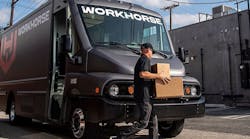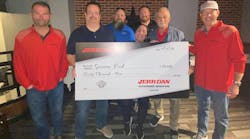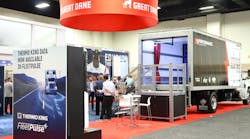Trailer and truck body manufacturers have been here before. They've had to switch the blowing agents used to produce foam insulation on panels and, in some cases, reconfigure their production processes. They have it down pat.
“We've had to make changes before with blowing agents,” says Rick Mullininx, VP of engineering for Great Dane. “When I first started with the company 25 years ago, we were using r11. It had a high ozone-depleting factor, so we switched to 141b. And then that was banned and so we switched to R-22. And that's now been banned. Experience helps in making the transition. We've come up with a system and process to evaluate them and cross all our T's and dot all our I's. We're very methodical about it.”
But while most manufacturers say the new regulation will not radically alter their manufacturing processes or compromise product quality, they say it will dramatically increase production costs.
“I think it's fair to say it'll be a substantial cost increase for all the trailer companies,” Mullininx says.
How substantial? He won't say.
Neither will Tracey Maynor, senior VP of sales and operations for VT Specialized Vehicles Corporation (VTSVC), the parent company of Hackney and Kidron, who adds, “It's a pretty significant amount per pound. In terms of passing that on to the customer, I don't know if the marketplace will accept an increase right now. The good thing is that some of the material costs have begun to stabilize, so the effects of a foam increase will be less visible to the marketplace. But with the reduced volumes that the marketplace is experiencing today, a manufacturer's ability to pass on a price increase is going to be very difficult.”
All of this is in reaction to the Montreal Protocol On Substances That Deplete the Ozone Layer, an international treaty in effect since January 1, 1989, and designed to protect the ozone layer by phasing out the production of substances with ozone depletion potential (ODP).
In the United States, Class I substances were subject to the first round of phaseout targets. Class I substances have an ODP of 0.2 or higher, and include halons, chlorofluorocarbons (CFCs), methyl chloroform, carbon tetrachloride, and methyl bromide.
Now in Class II
Section 604 of the Environmental Protection Agency's (EPA) Clean Air Act set the phaseout targets for Class I substances, including a ban on production and import of halons that took effect on January 1, 1994, and a ban on production and import of other Class I ODS — excluding methyl bromide — that took effect on January 1, 1996.
Class II controlled substances have an ODP of less than 0.2 and were subject to a later phaseout schedule than Class I substances. Class II substances are all hydrochlorofluorocarbons (HCFCs), which were developed as transitional substitutes for Class I substances and have many of the same uses as CFCs.
Of the 34 HCFCs, the most widely used have been HCFC-22 (a commercial refrigerant), HCFC-141b (a solvent and foam-blowing agent), and HCFC-142b (a foam-blowing agent and component in refrigerant blends).
The phaseout framework was established by EPA's January 21, 2003, final rule (68 FR 2819), which banned the production and import of virgin HCFC-141b. The production and import of virgin HCFC-22 and HCFC-142b were to be banned on January 1, 2010. But at the 19th Meeting of the Parties in Montreal last September, the Parties agreed to a more aggressive phasedown of HCFCs, adopting a March 1 deadline.
Mullininx says Great Dane has chosen to go with 245 instead of R-22, but the transition will be “seamless” because all of the company's machines are compatible with the new system.
“We did a lot of work to make sure it was seamless, but it's proven to be no problem,” he says. “We ran manufacturing trials. We go through a multi-step process. We have vendors supply us with sample foam panels. We evaluate those compared to our criteria, and if the samples they provided meet our criteria, we schedule a manufacturing trial. That will be several trailers' worth of production so we can evaluate how it works and if we need to change manufacturing parameters. We also take those panels and send them to our research and development facility and do a gamut of tests to evaluate strength. If all goes well, we approve the system for use in production.”
Great Dane has converted its plant in Wayne, Nebraska, and will convert those in Savannah, Georgia, and Brazil, Indiana, in the first two months of this year.
Mullininx says all the parameters are the same with 245, but the peel strength is a bit higher.
“If you took the liner of the trailer and just tried to peel it off, it's slightly stronger,” he says. “It has better delamination resistance. It must be something in the structure of the cells. I don't know the chemistry of exactly how it worked out. Perhaps it was in the fact that 245 has a higher blowing point. I don't know if I came in with expectations one way or the other, but I was certainly pleased it was higher.”
Maynor says VTSVC has chosen 134a and doesn't expect any changes in the manufacturing processes for its refrigerated bodies and Emperor food service trailers.
“I think the 134a tends to be a little more fickle when you're shooting it, so temperature control and your presses and equipment are going to be more important than they were with 22, but it's an important part of the process anyway,” he says. “As long as you're controlling your mix ratio and temperature, there should be no quality difference between 134 and 22. If anything, the 134, based on our tests, will provide less opportunity for foam shrinkage.”
Supply shortage
He says the biggest issue is that their suppliers are not necessarily ready to supply. One of the foam suppliers did not commercialize its sales of 134 until the end of December. VTSVC took its first shipment of 134 during the first week of January.
Its first plant switchover came January 4 in Lakeland, Florida. The remaining R-22 material was shipped to the company's other plants in Montgomery, Pennsylvania, Tulare, California, and Kidron, Ohio, which will use the rest of the supply by February 1.
Howard Yurgevich, VP of research and development for Hyundai, says the company will be switching from 141b to an undetermined blowing agent — either 245, cyclopentane, or water — for its refrigerated trailers.
“Water is very good because you don't have any problem with ozone depletion and obviously it's easily available and probably has the lowest cost addition,” he says. “But it does require a higher density to maintain the stability of the trailer and foaming. It's not as efficient an insulator. During the processing, you have a certain amount of time to do everything. With water, that window is much smaller than with some of the other blowing agents. You're paying for it one way or the other.
“245 has better insulating factors and no ozone-depletion potential, but it's very costly to purchase and use, you definitely do have to modify the equipment, and it will froth. It may tend to start foaming a little sooner than expected.
“Cyclopentane is not as expensive as 245 and it has reasonable insulating properties to it. The problem is that it's considered a flammable liquid. It condenses at room temperature, which is not a good thing. You also have to use higher densities to maintain the dimensions you're looking for, and it does require probably the most expensive upgrades.
“When we switch over, we will basically switch to all new equipment. We could spend up to half a million dollars on that. What people now have to do is change over the equipment to allow them to use the different chemicals, and then you have to go and work out the proper proportions. There is a phase-in period where you experiment to make sure you get it balanced out for the different designs you have. We're trying to take a slow and deliberate approach to that.”
He says that regardless of which blowing agent they choose, the trailer probably will be heavier.
“How are we going to maintain the dimensional stability if we're going to go to a heavier, denser foam?” he says. “We have a certain clamping action in our jigs and fixtures right now, so that as you pour the foam and it starts expanding, it presses the roof or sidewall out. If you don't keep that nice and smooth and clamped together, you get all these bows in the sheets between the stiffeners on the sidewalls, floor, and roof. We have a very flat surface after foaming with the clamp action we now have. We have to experiment a bit more to make sure that during the different foaming stages, we have significant clamping force to overcome any problems. When we get to thicker foaming, we may have to add clamping action to the overall press system.
“And obviously we have to change our computers to allow us to formulate everything. Everything we do for foaming is computer-controlled. All the operator has to do is dial in what location he is on the trailer, press a button and the computer takes care of everything else. So for every shot — which is where he puts insulation foam into the trailer cavity — it's recorded on the computer for each trailer at each position so we know how much foam we put into each cavity on any given trailer at any given time.”
What does the future hold?
As of January 1, 2015, as part of the phaseout of all HCFCs, the sale and use of HCFC-22 and HCFC-142b will be banned except for transformation or servicing refrigeration and air-conditioning applications. The EPA will not permit newly manufactured HCFC-22, HCFC-142b, or blends containing either substance, to be used for charging new equipment.
Starting January 1, 2020, the production and import of HCFC-22 and HCFC-142b will be banned entirely in the United States. Once this happens, only recycled/reclaimed or stockpiled quantities of HCFC-22 and HCFC-142b will be available for servicing existing equipment.
But manufacturers will worry about that when the time comes.








